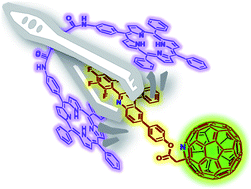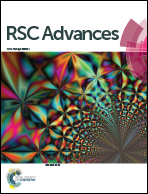Solution-phase molecular recognition of an azafullerene-quinoline dyad by a face-to-face porphyrin-dimer tweezer†
Abstract
A face-to-face porphyrin dimer, (H2P)2 “porphyrin tweezer”, was explored as a photo- and redox-responsive host for the molecular recognition of an azafullerene (C59N) derivative bearing an amphoteric pentafluoroquinoline (FQ) domain. The intramolecular electronic coupling between the FQ substituent and the C59N cage, within the newly synthesized C59N-FQ dyad was evaluated, while the neutral and protonated form of the covalently attached FQ moiety were utilized as recognition motifs for the (H2P)2 tweezer. Complementary photophysical and electrochemical techniques were applied to investigate the electronic communication between the porphyrin-dimer (H2P)2 tweezer and the azafullerene cage as mediated by the FQ unit.



 Please wait while we load your content...
Please wait while we load your content...